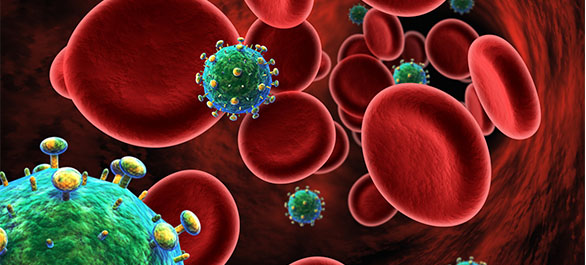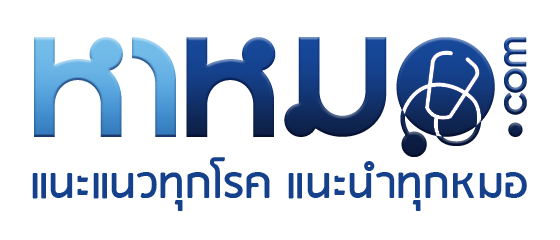
การจัดการภาวะแทรกซ้อนจากยาต้านรีโทรไวรัส-19
- โดย ภก.วิชญ์ภัทร ธรานนท์
- 17 ธันวาคม 2561
- Tweet

สาเหตุ
ยากลุ่ม NRTIs โดยเฉพาะ ไดดาโนซีน (didanosine) สตาวูดีน (stavudine) และ ซิโดวูดีน(zidovudine) เรียงตามลำดับที่พบบ่อยจากมากไปน้อย และการให้ยาทีโนโฟเวียร์ (tenofovir disoproxil fumarate) ร่วมกับ ไดดาโนซีน (didanosine) ยาอื่นที่ทำให้เกิดได้แต่พบน้อย คือ ลามิวูดีน (lamivudine) เอมตริไซตาบีน (emtricitabine) และทีโนโฟเวียร์ tenofovir disoproxil fumarate กลไกการเกิดเป็นมาจากภาวะเป็นพิษต่อไมโทคอนเดรียที่เกิดจากการยับยั้ง mitochondrial DNA polymerase γ ที่ทำให้เกิดขบวนการ ไกลโคไลซิสแบบไม่ใช้ออกซิเจน และการสร้างแลกเตด ภาวะกรดแลคติกคั่งพบไม่บ่อยแต่มีความรุนแรง ในปัจจุบันนี้อาจพบน้อย เพราะการใช้ยาไดดาโนซีน และสตาวูดีนน้อยลง ปัจจัยเสี่ยง คือ ระยะเวลาที่ได้รับยาต้านรีโทรไวรัส โดยเฉพาะอย่างยิ่งยากลุ่ม NRTIs การติดเชื้อไวรัสตับอักเสบบีและซี หรือมีโรคตับอื่นๆ จำนวน CD-4 ต่ำ เป็นเพศหญิง ตั้งครรภ์และอ้วน
อาการและอาการแสดง
อาการมักเกิดขึ้นหลังได้รับยาต้านรีโทรไวรัสไปแล้วประมาน 3 - 4 เดือน แต่อาจจะ พบได้ตั้งแต่ 1 - 20 เดือน อาการแสดงของภาวนี้พบได้ตั้งแต่ไม่แสดงอาการ หรือมีอาการแสดงเพียงเล็กน้อยจนถึงภาวะที่เป็นอันตรายต่อชีวิต อาการที่พบไม่จำเพาะ ได้แก่ อาการคลื่นไส้ อาจเจียน ปวดท้อง น้ำหนักลด ปวดเมื้อยกล้ามเนื้อ และอ่อนเพลีย บางรายอาจมีอาการรุนแรง เช่น หัวใจเต้นเร็ว หายใจเร็ว เหลือง กล้ามเนื้ออ่อนแรง หายใจลำบาก หอบเหนื่อยและการทำงานของอวัยวะต่างๆล้มเหลว เช่น ตับวาย ไตวาย ซึ่งมีโอกาสเสียชีวิตสูงมากถึง 50% โดยอย่างยิ่งผู้ป่วยที่มีระดับแลคเตดในซีรั่มมากกว่า 10 มิลลิโมล/ลิตร เกณฑ์การวินิจฉัยแลตเตดในเลือดสูงที่มีอาการ คือ แลคเตดในซีรั่มตั้งแต่ 4.5 มิลลิโมล/ลิตรขึ้นไป แต่ระดับไบคาร์บอนเนตและค่าพีเอชในเลือดปกติ ส่วนภาวะการวินิจฉัยภาวะกรดแลคติกคั่ง คือ ระดับแลคเตดในซีรั่มตั้งแต่ 5 มิลลิโมล/ลิตร ร่วมกับค่าพีเอชในเลือดน้อยกว่า 7.34 และหรือระดับไบคาร์บอนเนตน้อยกว่า 18 มิลลิโมล/ลิตร บางรายอาจมีค่าเอนไซม์ตับสูงขึ้นรวมทั้งบิลิรูบินสูงและมี prothrombin time ยาว ผู้ที่มีตับอ่อนอักเสบร่วมด้วยจะมีระดับ amylase และ lipase สูง
การป้องกัน
หลีกเลี่ยงการใช้ยาที่ทำให้เกิดอาการไม่พึงประสงค์นี้ โดยเฉพาะ ไดดาโนซีน (didanosine) สตาวูดีน (stavudine) และซิโดวูดีน(zidovudine) ทั้งที่ใช้เป็นยาเดี่ยวหรือยาใช้ร่วมกัน กรณีต้องการใช้ยากลุ่ม NRTIs ควรเลือกยาทีโนโฟเวียร์ (tenofovir disoproxil fumarate; TDF) หรืออะบาคาเวียร์ (abacavir; ABC) เป็นทางเลือกแรก รองลงไป คือ ลามิวูดีน (lamivudine; 3TC) โดยไม่แนะนำให้ตรวจแลคเตด ถ้าไม่มีอาการหรือไม่ได้สงสัยว่าจะมีระดับแลคเตดสูงหรือไม่มีภาวะกรดแลคติกคั่ง เนื่องจาก จะพบระดับแลคเตดสูงในซีรั่มได้บ่อยแต่ไม่มีอาการ โดยมีค่าตั้งแต่ 2 ถึง 5 มิลลิโมล/ลิตร
หากผู้ป่วยได้รับยาต้านรีโทรไวรัสอยู่ แล้วเกิดอาการไม่พึงประสงค์ดังกล่าว ข้างต้น หรือมีความผิดปกติอื่นๆ ควรรีบไปพบแพทย์โดยทันที เพื่อให้ได้รับการรักษาอย่างรวดเร็ว
การรักษา
ตารางการจัดการภาวะแลคเตดในเลือดสูงและกรดแลคติกคั่งในผู้ป่วยเอชไอวี
| ไม่มีอาการ (Asymptomatic) | Lactate < 2 mmol/L | ไม่มีการจัดการใดๆ |
| มีอาการ (Symptomatic) | Normal bicarbonate Lactate < 2 mmol/L |
-ไม่มีการจัดการใดๆ -พิจารณาสาเหตุอื่นๆที่อาจเกี่ยวข้อง |
| มีอาการ (Symptomatic) | Normal bicarbonate Lactate 2.1 – 5.0 mmol/L |
-พิจารณาเปลี่ยนยา ddI และ d4T เป็นยาชนิดอื่น -พิจารณาหยุดยาต้านรีโทรไวรัสชั่วคราว แล้วหาสาเหตุ |
| มีอาการ (Symptomatic) | Lactate > 5.0 mmol/L | -หยุดยาต้านรีโทรไวรัสทุกตัว -หยุดยาอื่นๆที่อาจส่งผลต่อภาวะดังกล่าวได้ -ให้การรักษาภาวะแลคเตดในเลือดสูงและกรดแลคติกคั่ง |
| ไม่มีอาการ หรือมีอาการ (Asymptomatic or symptomatic) | Lactate > 10 mmol/L |
ผู้ที่ไม่มีอาการมักจะมีระดับแลคเตดน้อยกว่า 5 มิลลิโมล/ลิตร ซึ่งไม่ต้องรักษาหรือ อาจจะเปลี่ยนยาต้านรีโทรไวรัสถ้าไม่มีข้อจำกัด โดยแนะนำให้เปลี่ยนยาที่สงสัยเป็นยาที่มีความจำเพาะเจาะจง (affinity) ต่อเอนไซม์ polymerase น้อยกว่า เช่น ทีโนโฟเวียร์ (tenofovir) และ อะบาคาเวียร์ (abacavir) อีกทางเลือกหนึ่ง คือ การไม่เลือกใช้ยากลุ่ม NRTIs เลย (nucleoside reverse transcriptase inhibitor-sparing regimens) เช่น การใช้ยาในกลุ่ม PIs ร่วมกับยากลุ่ม NNRTIs แทน
ผู้ป่วยที่มีอาการมักมีระดับแลคเตดสูงกว่า 10 มิลลิโมล/ลิตร ซึ่งถือเป็นภาวะฉุกเฉิน เนื่องจากอัตราเสียชีวิตสูง ต้องหยุดยาที่คาดว่าเป็นสาเหตุทันทีและรักษาตามอาการ โดยการให้สารน้ำและเกลือแร่อย่างเพียงพอ อาจต้องให้ไบคาร์บอเนตทางหลอดเลือดดำหรือฟอกไตและใช้เครื่องช่วยหายใจกรณีเลือดมีความเป็นกรดมาก
บรรณานุกรม:
- Department of disease control, Thailand National Guidelines on HIV/AIDS Treatment and Prevention 2017. availavle from http://www.thaiaidssociety.org/images/PDF/ hiv_thai_guideline _2560.pdf.
- Cohen DE, Mayer KH. Primary care issues for HIV-infected patients. Infect Dis Clin N Am 21 (2007): 49–70.
- วีรวัฒน์ มโนสุทธิ. Current management of complication of antiretroviral therapy. ใน: ชาญกิจ พุฒิเลอพงศ์, ณัฏฐดา อารีเปี่ยม, แสง อุษยาพร, บรรณาธิการ. Pharmacotherapy in infectious disease VII. กรุงเทพมหานคร. สำนักพิมพ์แห่งจุฬาลงกรณ์มหาวิทยาลัย. 2558, หน้า 198-201.
- Group TISS. Initiation of Antiretroviral Therapy in Early Asymptomatic HIV Infection. New England Journal of Medicine. 2015;373(9):795-807.
- Group TTAS. A Trial of Early Antiretrovirals and Isoniazid Preventive Therapy in Africa. New England Journal of Medicine. 2015;373(9):808-22.
- Ayoko R. Bossou SC, Karen K. O’Brien, Catherine A. Opere, Christopher J. Destache. Preventive HIV Vaccines: Progress and Challenges. US Pharmacist. 2015 OCTOBER 16, 2015:46-50.
- รัชนู เจริญพักตร์ และ ชาญกิจ พุฒิเลอพงศ์. Current update on HIV/AIDs treatment guideline in 2017. ใน: ชาญกิจ พุฒิเลอพงศ์, โชติรัตน์ นครานุรักษ์, และ แสง อุษยาพร, บรรณาธิการ. Pharmacotherapy in infectious disease IX. กรุงเทพมหานคร. สำนักพิมพ์แห่งจุฬาลงกรณ์มหาวิทยาลัย. 2560, หน้า 342-364.
- Wada N JL, Cohen M, French A, Phair J, Munoz A. Cause-specific life expectancies after 35 years of age for human immunodeficiency syndrome-infected and human immunodeficiency syndrome-negative individuals followed simultaneously in long-term cohort studies, 1984-2008. Am J Epidermol. 2013; 177: 116-125.
- Department of Health and Human Services. Guidelines for the Use of Antiretroviral Agents in Adults and Adolescents Living with HIV Available from: https://aidsinfo.nih.gov/guidelines.
- O'Brien ME, Clark RA, Besch CL, Myers L, Kissinger P. Patterns and correlates of discontinuation of the initial HAART regimen in an urban outpatient cohort. Journal of acquired immune deficiency syndromes (1999). 2003;34(4):407-14.
- Kiertiburanakul S, Luengroongroj P, Sungkanuparph S. Clinical characteristics of HIV-infected patients who survive after the diagnosis of HIV infection for more than 10 years in a resource-limited setting. Journal of the International Association of Physicians in AIDS Care (Chicago, Ill : 2002). 2012;11(6):361-5.
- Wiboonchutikul S, Sungkanuparph S, Kiertiburanakul S, Chailurkit LO, Charoenyingwattana A, Wangsomboonsiri W, et al. Vitamin D insufficiency and deficiency among HIV-1-infected patients in a tropical setting. Journal of the International Association of Physicians in AIDS Care (Chicago, Ill : 2002). 2012;11(5):305-10.
- Wilde JT, Lee CA, Collins P, Giangrande PL, Winter M, Shiach CR. Increased bleeding associated with protease inhibitor therapy in HIV-positive patients with bleeding disorders. British journal of haematology. 1999;107(3):556-9.
- European AIDS Clinical Society. EACS Guidelines version 8.1-October 2016. Available from http://www.eacsociety.org/files/guidelines_8.1-english.pdf.
- ศศิโสภิณ เกียรติบูรณกุล. การดูแลรักษาผู้ติดเชื้อเอชไอวีแบบผู้ป่วยนอก.กรุงเทพฯ : ภาควิชาอายุรศาสตร์ คณะแพทยศาตร์โรงพยาบาลรามาธิบดี มหาวิทยาลัยมหิดล, 2557
- Morse CG, Mican JM, Jones EC, Joe GO, Rick ME, Formentini E, et al. The incidence and natural history of osteonecrosis in HIV-infected adults. Clinical infectious diseases : an official publication of the Infectious Diseases Society of America. 2007;44(5):739-48.
- Woodward CL, Hall AM, Williams IG, Madge S, Copas A, Nair D, et al. Tenofovir-associated renal and bone toxicity. HIV medicine. 2009;10(8):482-7.
- Wang H, Lu X, Yang X, Xu N. The efficacy and safety of tenofovir alafenamide versus tenofovir disoproxil fumarate in antiretroviral regimens for HIV-1 therapy: Meta-analysis. Medicine. 2016;95(41):e5146.
- Redig AJ, Berliner N. Pathogenesis and clinical implications of HIV-related anemia in 2013. Hematology American Society of Hematology Education Program. 2013;2013:377-81.
- Assefa M, Abegaz WE, Shewamare A, Medhin G, Belay M. Prevalence and correlates of anemia among HIV infected patients on highly active anti-retroviral therapy at Zewditu Memorial Hospital, Ethiopia. BMC Hematology. 2015;15:6.
- de Gaetano Donati K, Cauda R, Iacoviello L. HIV Infection, Antiretroviral Therapy and Cardiovascular Risk. Mediterranean Journal of Hematology and Infectious Diseases. 2010;2(3):e2010034.
- Group TDS. Class of Antiretroviral Drugs and the Risk of Myocardial Infarction. New England Journal of Medicine. 2007;356(17):1723-35.
- Tsiodras S, Mantzoros C, Hammer S, Samore M. Effects of protease inhibitors on hyperglycemia, hyperlipidemia, and lipodystrophy: a 5-year cohort study. Archives of internal medicine. 2000;160(13):2050-6.
- วราภณ วงศ์ถาวราวัฒน์. Diagnosis and classification of Diabetes Mellitus. ใน: ธิติ สนับบุญ, บรรณาธิการ. แนวทางเวชปฏิบัติทางต่อมไร้ท่อ. กรุงเทพมหานคร.โรงพิมพ์แห่งจุฬาลงกรณ์มหาวิทยาลัย. 2560, หน้า 1-9.
- ชาญกิจ พุฒิเลอพงศ์. Clinical management for dyslipidemia in HIV-infected patients. ใน: ชาญกิจ พุฒิเลอพงศ์ และ ณัฏฐดา อารีเปี่ยม, บรรณาธิการ. Pharmacotherapy in infectious disease VI. กรุงเทพมหานคร. คอนเซ็พท์พริ้นท์. 2557, หน้า 198-201.
- Dube MP, Stein JH, Aberg JA, Fichtenbaum CJ, Gerber JG, Tashima KT, et al. Guidelines for the evaluation and management of dyslipidemia in human immunodeficiency virus (HIV)-infected adults receiving antiretroviral therapy: recommendations of the HIV Medical Association of the Infectious Disease Society of America and the Adult AIDS Clinical Trials Group. Clinical infectious diseases : an official publication of the Infectious Diseases Society of America. 2003;37(5):613-27.
- Hoffman RM, Currier JS. Management of antiretroviral treatment-related complications. Infectious disease clinics of North America. 2007;21(1):103-32, ix.
- Husain NEOS, Ahmed MH. Managing dyslipidemia in HIV/AIDS patients: challenges and solutions. HIV/AIDS (Auckland, NZ). 2015;7:1-10.
- Kiertiburanakul S, Sungkanuparph S, Charoenyingwattana A, Mahasirimongkol S, Sura T, Chantratita W. Risk factors for nevirapine-associated rash among HIV-infected patients with low CD4 cell counts in resource-limited settings. Current HIV research. 2008;6(1):65-9.
- Murphy RL. Defining the toxicity profile of nevirapine and other antiretroviral drugs. Journal of acquired immune deficiency syndromes (1999). 2003;34 Suppl 1:S15-20.
- Department of Health and Human Services. HIV and Lactic Acidosis. Available from: https://aidsinfo.nih.gov/understanding-hiv-aids/fact-sheets/22/68/hiv-and-lactic-acidosis.
- Grinspoon S, Carr A. Cardiovascular Risk and Body-Fat Abnormalities in HIV-Infected Adults. New England Journal of Medicine. 2005;352(1):48-62.
- Simpson D, Estanislao L, Evans S , McArthur J, Marcusd K, Truffa M et,al. HIV-associated neuromuscular weakness syndrome. AIDS (London, England). 2004;18(10):1403-12.
- Hall AM, Hendry BM, Nitsch D, Connolly JO. Tenofovir-associated kidney toxicity in HIV-infected patients: a review of the evidence. American journal of kidney diseases : the official journal of the National Kidney Foundation. 2011;57(5):773-80.
- Chaisiri K, Bowonwatanuwong C, Kasettratat N, Kiertiburanakul S. Incidence and risk factors for tenofovir-associated renal function decline among Thai HIV-infected patients with low-body weight. Current HIV research. 2010;8(7):504-9.
- Schwarzwald H, Gillespie S. Management of Antiretroviral-Associated Complications. Available from: https://bipai.org/sites/bipai/files/5-Mgt-assoc-complications.pdf
- ศศิโสภิณ เกียรติบูรณกุล. Practical management of complication-associated with ARVใน: นารัต เกษตรทัต, ชาญกิจ พุฒิเลอพงศ์ และ ณัฏฐดา อารีเปี่ยม, บรรณาธิการ. Pharmacotherapy in infectious disease VI. กรุงเทพมหานคร. คอนเซ็พท์พริ้นท์. 2554, หน้า 317-346.


